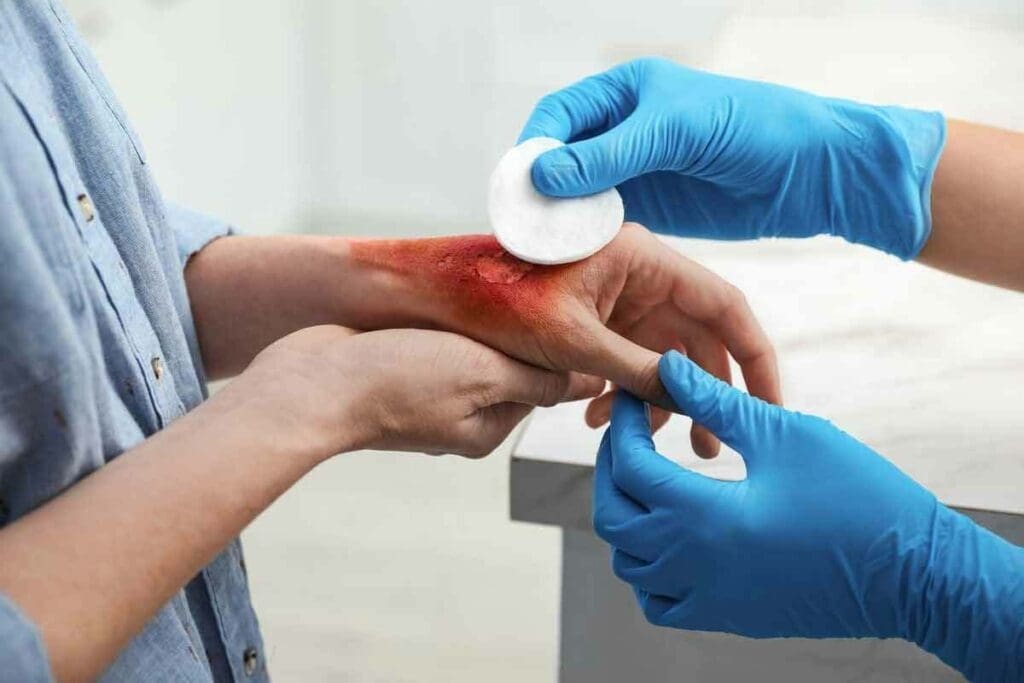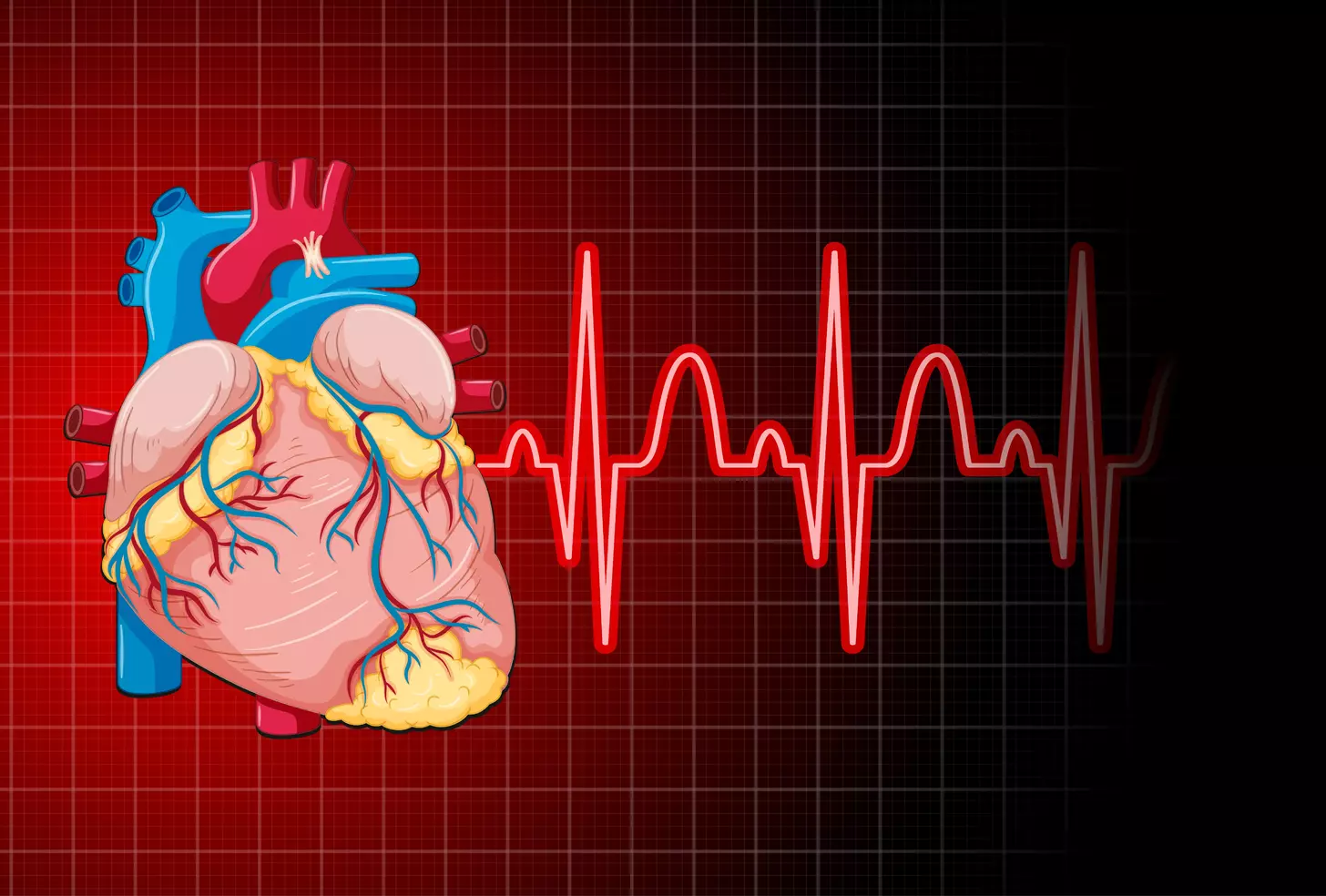Last Updated on November 27, 2025 by Bilal Hasdemir

Burns are serious injuries that can harm more than just the skin. They can damage internal tissues, too. Knowing the different types of burns is key to the right treatment. At Liv Hospital, we offer top-notch care for burn patients.Supporting a radiation burn victim? Get 7 crucial facts about the different types and degrees of burns caused by radiation exposure.
As a top healthcare provider, we see many kinds of burns. Our team uses the latest treatments to help patients heal. This article will cover the seven types of burns, their levels, causes, and how they’re classified. It’s all to help you understand your condition and the care you can get.
Key Takeaways
- There are seven types of burns, each with different causes and severity levels.
- Understanding burn classification is essential for effective treatment.
- Burns can cause damage beyond the skin, affecting internal tissues.
- Liv Hospital provides world-class, patient-centered care for burn victims.
- Proper care and treatment can significantly support recovery.
The Science of Burn Injuries

It’s important to know how burn injuries work to find better treatments and ways to prevent them. Burns happen when skin or other tissues get damaged by heat, electrical discharge, friction, chemicals, or radiation. The damage can be mild or severe, depending on how deep and wide it is.
How Tissue Damage Occurs in Burns
Burns damage skin cells and tissues because of harmful agents. The damage’s extent depends on the agent, how hot it is, and how long it stays in contact with the skin. For example, thermal burns from flames or hot surfaces damage tissues right away. On the other hand, chemical burns keep causing damage as long as the chemical touches the skin.
We sort burns into different levels based on how deep and wide the damage is. Knowing the burn’s level helps doctors decide the right treatment and what to expect. It’s key to understand the burn’s level to know how serious it is.
Burn Statistics and Public Health Impact
Burns affect many people worldwide, causing millions of injuries each year. The public health impact is big, with burns leading to many illnesses and deaths, mostly in countries with less access to burn care. In the U.S., thousands of people go to the hospital for burns every year, needing special care.
We need to look at the numbers and how burns affect health to make better prevention plans and improve care. By learning about burn causes and effects, we can lower their numbers and help those who get them.
Burn Classification: Understanding the Degree System

Knowing how to classify burns is key to figuring out how serious they are. It helps doctors decide the best treatment. The depth of the burn damage is what matters most.
First-Degree Burns: Superficial Damage
First-degree burns only harm the top layer of the skin, called the epidermis. They cause redness, swelling, and pain. These burns usually heal quickly without leaving scars. Common examples include mild sunburns.
Second-Degree Burns: Partial-Thickness Injuries
Second-degree burns go deeper, into the dermis. They have blisters, redness, and swelling. These burns hurt a lot and take longer to heal. The presence of blisters is a hallmark of second-degree burns.
Third-Degree Burns: Full-Thickness Damage
Third-degree burns destroy the epidermis and dermis and might reach deeper tissues. They look white, leathery, or charred and may not hurt as much. Third-degree burns need quick medical help and often need skin grafts.
Fourth-Degree Burns: Damage to Deeper Structures
Fourth-degree burns are the worst. They go through the skin and harm deeper tissues like muscle or bone. These burns are very dangerous and need immediate care. The extent of damage in fourth-degree burns is extensive, often resulting in significant long-term consequences.
Understanding the degree system helps doctors treat burns better. It tells them how serious the burn is and what treatment is needed. This includes whether surgery is required and what risks there might be.
Second-Degree vs. Third-Degree Burns: Critical Differences
It’s important to know the differences between second-degree and third-degree burns. This knowledge helps in giving the right care and treatment. These burns vary in severity, symptoms, and treatment needed.
Appearance and Physical Characteristics
Second-degree burns, or partial-thickness burns, affect the top two layers of the skin. They show redness, swelling, and blisters. The skin looks moist and shiny.
Third-degree burns, or full-thickness burns, go through all skin layers and can harm deeper tissues. They look white, leathery, or charred and don’t usually blister.
A medical expert says, “Burn appearance is key to knowing its severity. Second-degree burns have blisters, while third-degree burns look charred or white due to deep damage.”
“Burn depth is a critical factor in determining the appropriate treatment and predicting outcomes.”
Burn Specialist
Pain Levels and Sensation Differences
Pain levels differ between second-degree and third-degree burns. Second-degree burns hurt because of damage to nerve endings. People say the pain is sharp or stinging.
Third-degree burns might not hurt as much in the burned area because nerves are destroyed. But the areas around the burn can be painful.
| Burn Type | Pain Level | Sensation |
| Second-Degree | High | Painful, sharp, or stinging sensation |
| Third-Degree | Variable | Less painful inthe affected area, possible numbness |
Healing and Scarring
Healing and scarring chances also vary. Second-degree burns heal in weeks, with some scarring risk. Third-degree burns need surgery and often cause more scarring.
Understanding these differences helps in treating burns better. Healthcare providers can then give the right care for each patient’s needs.
Thermal Burns: From Flames to Scalds
Exposure to flames, hot liquids, or steam can cause thermal burns. These burns are common and can be very serious. They need quick medical help.
Causes and Risk Factors
Thermal burns come from many sources. This includes open flames, scalding liquids, and contact with hot surfaces. Some common risks are:
- Cooking accidents involving hot oils or boiling water
- House fires or explosions
- Contact with hot appliances or electrical devices
- Scalding from steam or hot liquids in industrial settings
Knowing these risks helps prevent burns. Taking safety steps can lower the chance of getting thermal burns.
Identifying Severity and Symptoms
The damage from thermal burns can range from mild to severe. Signs include:
- Redness and swelling
- Blisters or charred skin
- Pain or loss of sensation
It’s important to know how bad a burn is. Superficial burns might just need basic care. But, more serious burns need a doctor’s help right away.
Immediate Response and Treatment Options
First, cool the burn with cool water for 10-15 minutes. This helps lower the skin’s temperature and eases pain. Treatment depends on the burn’s severity:
- Minor burns might just need antibiotic ointments and bandages.
- Severe burns need a doctor’s care, which could include skin grafting or other treatments.
Watch for infection signs and follow the doctor’s advice on wound care and healing.
Chemical Burns: When Substances Attack Tissue
Corrosive substances can cause severe chemical burns when they touch human skin. These burns can damage skin and deeper tissues. They can happen from household cleaners, industrial chemicals, and other dangerous materials.
Household and Industrial Chemical Hazards
Many household items, like bleach and drain cleaners, can burn skin. Workers in industries face even more risks from acids and alkalis. Knowing the dangers of these chemicals helps prevent burns.
Prevention is key. Always handle these chemicals with care. Wear gloves and goggles when needed. Also, store and dispose of them safely to avoid accidents.
Unique Characteristics of Chemical Burns
Chemical burns are different from thermal burns. Their severity depends on the chemical, its strength, and how long you’re exposed. Some chemicals damage right away, while others keep causing harm over time.
The ongoing damage of some burns means quick first aid is vital. It helps prevent long-term harm.
Specialized First Aid and Medical Interventions
First aid for chemical burns starts with removing the chemical and rinsing with water. But the right steps vary by chemical. Some should not be rinsed with water, as it can make the burn worse.
Medical help for chemical burns includes wound care and pain management. In serious cases, surgery might be needed. Seek medical help right away for severe burns, large areas, or burns from strong acids or alkalis.
Prompt medical care is key to avoiding long-term damage and scarring. We’ll look at why quick medical attention is important and the treatment options for chemical burns.
Understanding the Radiation Burn Victim: Beyond Skin Damage
Ionizing radiation can cause radiation burns, more than just skin damage. We’ll look into the complexities of these burns. This includes their causes, symptoms, and treatment challenges.
Sources and Types of Radiation Exposure
Radiation burns can come from nuclear accidents, industrial equipment, or medical procedures. The damage depends on the dose and how long you’re exposed.
There are two main types of exposure. Acute exposure is a high dose over a short time. Chronic exposure is lower doses over a longer time.
Acute vs. Chronic Radiation Burns
Acute radiation burns happen right after a high dose. They can severely damage skin and organs. Chronic burns develop slowly from long-term exposure to lower doses.
Knowing the difference is key the right treatment and understanding recovery chances.
Treatment Challenges and Long-Term Management
Treating radiation burns is hard because of the damage’s complexity. Care might include wound management, pain relief, and surgery.
Managing burns long-term needs a team effort. This includes medical care, psychological support, and rehabilitation. It helps with both physical and emotional recovery.
| Aspect | Acute Radiation Burns | Chronic Radiation Burns |
| Exposure Duration | Short-term, high dose | Long-term, lower dose |
| Symptoms Onset | Immediate | GrGraduallyover time |
| Treatment Approach | Emergency care, wound management | Ongoing monitoring, wound care |
Electrical Burns: The Hidden Danger
Electrical burns happen when the body becomes part of an electrical circuit. This causes damage that might not be seen right away. These burns can come from touching electrical currents, leading to both outside and inside injuries.
We will look into the details of electrical burns. We’ll talk about what causes them, how hard it is to see internal damage, and the possible problems that can happen.
Entry and Exit Wounds: The Electrical Pathway
When someone touches an electrical source, the current goes in at one spot and out at another. This makes entry and exit wounds. These wounds show where the electrical current went through the body.
The burn’s severity isn’t always clear from the outside wounds. Even if the entry and exit wounds look small, the inside damage can be big.
Internal Damage Assessment Challenges
It’s hard to see the internal damage from electrical burns. We use special tools to check how bad it is.
The path the electrical current takes through the body affects where it hurts the most. Internal organs and tissues can get badly damaged, even if there’s no clear sign of injury on the outside.
Cardiac and Neurological Complications
Electrical burns can cause serious heart and brain problems. The electrical current can mess up the heart and hurt the brain.
| Complication | Description | Potential Outcome |
| Cardiac Arrest | Disruption of heart function due to the electrical current | Life-threatening if not treated promptly |
| Neurological Damage | Damage to the nervous system from the electrical current | Potential for long-term neurological deficits |
Knowing the dangers of electrical burns is key to getting the right medical care. It helps avoid serious long-term problems.
Less Common Burn Types: Friction, Cold, and Laser
Burns from friction, cold, and lasers are not as well-known as others. They need a special understanding of their causes and how to treat them. Knowing about these burns is important for proper care.
Friction Burns: Mechanism and Treatment
Friction burns happen when skin rubs against a rough surface. This is common in sports, like those with ropes or fast movements.
Treatment for friction burns includes cleaning the area and using antibiotics to prevent infection. A non-stick dressing is also applied. Severe cases might need more medical attention.
Cold Burns and Frostbite: The Freezing Injury
Cold burns, or frostbite, occur when skin freezes from extreme cold. Symptoms include numbness, tingling, and pale or blue skin.
Initial treatment for frostbite is warming the area in warm water. It’s important to manage pain and avoid rubbing the area.
Laser Burns: Modern Technology Hazards
Laser burns are caused by high-intensity laser beams. They can harm the skin and eyes. These burns are a big concern in places where lasers are used.
Prevention is key to avoiding laser burns. This includes wearing protective eyewear and skin coverings. Treatment involves cooling the area and managing pain, with further care as needed.
Emergency Response and Modern Burn Treatment
Burn injuries need quick and proper emergency care to lessen harm and boost survival odds. Knowing when to get medical help and the latest in burn care is key to good treatment and healing.
When to Seek Immediate Medical Attention
It’s vital to know how serious a burn is to decide what to do next. We suggest getting medical help fast for burns that are big, deep, or on sensitive spots like the face, hands, or feet. Burns from chemicals, electricity, or radiation also need special care.
Advancements in Burn Care and Skin Grafting
Modern burn treatment has made big strides, using new wound care methods and skin grafting to help heal. Skin grafting moves healthy skin to damaged areas to help them heal and lower infection risk.
Advances in burn care include bioengineered skin and advanced dressings that help wounds heal better. These new tools have made patients’ recovery times shorter and outcomes better.
Psychological Recovery and Support
Burn injuries hurt not just the body but also the mind. Giving psychological support is key to a full recovery. This support can be counseling, therapy, or joining support groups to help patients deal with their injuries.
We believe in a team effort in burn care, including mental health support. This way, patients get all-around care. It helps them heal and get back to a better life.
Conclusion: The Future of Burn Prevention and Care
We’ve looked at the various types of burns, like thermal, chemical, electrical, and radiation burns. Each has its own traits and treatment hurdles. This shows us how vital burn prevention and care are for better outcomes for those affected.
New advancements in burn care and prevention are on the rise. They aim to improve results for burn victims, including those from radiation. By taking steps to prevent burns, we can lower their occurrence.
It’s key to spread the word about burn risks and effects. The future of treating burns looks bright, thanks to ongoing research and new technologies.
Knowing about the different burns and their treatments helps us lessen their impact. This way, we can make burn treatment and care better for everyone in the future.
FAQ
What are the different types of burns?
There are seven types of burns. These include thermal, chemical, radiation, electrical, friction, cold, and laser burns. Each type has its own causes and effects.
How are burns classified?
Burns are sorted by degree. This shows how severe the damage is. Degrees range from first (superficial) to fourth (deep damage).
What is the difference between second-degree and third-degree burns?
Second-degree burns hurt and cause blisters. They affect the top two layers of skin. Third-degree burns are worse. They go through all skin layers and might make you numb. They often need surgery.
What are the symptoms of thermal burns?
Thermal burns can make skin red, swollen, and blistered. They can also char. Seeing a doctor right away is key to avoiding infection and helpinging with healing.
How do chemical burns occur?
Chemical burns happen when skin comes into contact with harmful substances. This can damage skin and deeper tissues.
What are the challenges in treating radiation burns?
Treating radiation burns is hard. They can harm internal organs and have long-term effects. Special care is needed to manage symptoms and prevent problems.
What are electrical burns, and how do they occur?
Electrical burns happen when electricity goes through the body. This can cause internal damage and heart problems.
How can friction burns be treated?
Friction burns need wound care and pain relief. In severe cases, skin grafting might be needed.
When should I seek medical attention for a burn?
Get medical help for severe burns, big burns, or burns with other symptoms. This includes trouble breathing or signs of infection.
What advancements have been made in burn care?
Burn care has improved a lot. Now, there’s better wound care, skin grafting, and support for the mind. These help burn victims heal better.
How can burn victims receive psychological support during recovery?
Burn victims get help through counseling and support groups. These help them deal with the emotional side of their injuries.
What is the importance of understanding burn classification?
Knowing about burn classification is key. It helps figure out how bad a burn is. This guides the right treatment to help with healing and avoid problems.
What are the different categories of burns based on their degree?
Burns are divided into four degrees. First-degree burns are superficial. Second-degree burns affect two layers. Third-degree burns go through all layers. Fourth-degree burns damage deeper structures.
How do different types of burns affect the skin and underlying tissues?
Burns can damage skin and tissues differently. This depends on the burn type, how bad it is, and how long it lasts.
References:
- American College of Radiology. (2024). ACR Appropriateness Criteria®. https://www.acr.org/Clinical-Resources/Clinical-Tools-and-Reference/Appropriateness-Criteria






